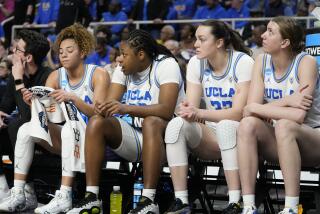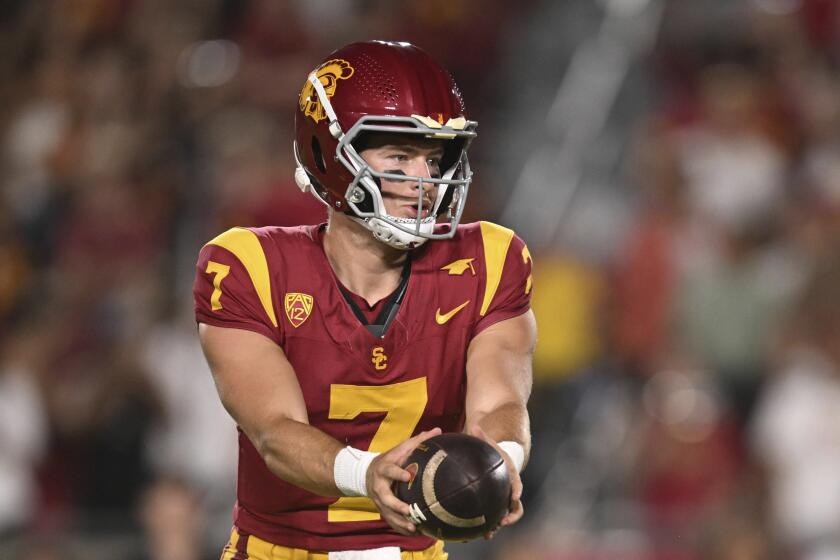Things could be stifling at the Final Four

ATLANTA -- This Final Four will be “lights out” on the scoreboard only if there’s a second-half power outage at the Georgia Dome.
(Hey, it already happened at one football stadium this year.)
Saturday’s two games in a vacuous, 75,000-seat venue have the potential to rekindle memories of the 1940 NCAA tournament. The semifinal scores that year were 39-30 and 43-42.
Wichita State is playing Louisville in Saturday’s first semifinal; Syracuse and Michigan in the nightcap. What jumps out about these matchups is not the jump shooters. It’s the way these schools play defense.
Shooting in a domed stadium is difficult enough without having to face this kind of barbed wire.
Wichita State has held four NCAA opponents to 34.3% shooting, and only 21 for 83 from three-point range. The Shockers’ motto is “play angry” and they’d rather add up floor burns than points after the game.
Louisville Coach Rick Pitino considered Marquette one of toughest defensive teams his Cardinals faced this year. Then he watched film of Wichita State.
“They are Marquette on steroids in terms of the way they play defense,” Pitino said.
Louisville is the only No. 1-seeded team left in the tournament and is the favorite to win it all because it plays the kind of frenetic style that can almost scare the ball out of an opponent’s hands. The Cardinals have held four tournament foes to an average of 59 points.
Louisville’s full-court press will miss the presence of guard Kevin Ware, who is sitting out after suffering a gruesomely broken leg in last week’s win over Duke. The Cardinals, though, aren’t likely to slow the pace.
“Pressure busts pipes,” Wichita State guard Malcolm Armstead said of Louisville. “You can’t allow what they do to change the way you play.”
Louisville wants opponents to catch the ball in corners so the defense can pounce like wolves. “They’re going to try and trap immediately,” Armstead said, “so it’s just a matter of staying away from the corners, not allowing them to turn you.”
Michigan is the best offensive team in the field, with shooting stars at every position. Guard Trey Burke is probably the best player still playing, and freshman forward Mitch McGary has emerged as an unexpected star. He has made 33 of 45 shots (73%) in the tournament and his 17.5 points per game leads the team.
Michigan has also played lock-down defense; its four opponents have made only 15 of 61 shots from three-point range.
The problem for Michigan’s offense Saturday is that it is facing a Syracuse defense that has been as dominating as any in recent NCAA history.
“I think that’s the first thing everyone knows about Syracuse,” Michigan forward Glenn Robinson III said. “It’s a tough matchup. They play that zone well.”
What makes Syracuse so good this year is size on the perimeter. Its guards, Michael Carter-Williams and Brandon Triche, are 6 feet 6 and 6-4. Ever try shooting over a canopy?
“We can’t fall in love with the three-point line, start taking deep threes,” Michigan’s Burke said. “We have to just try to find different ways to attack the zone.”
Syracuse is the first team in the shot-clock era to hold three opponents to fewer than 50 points. Opponents have shot only 28.9% against Syracuse in the tournament, making only 14 of 91 from three-point range (15.4%).
Montana connected on four of 31 three-pointers and finished with only 11 baskets in the game. Marquette made three of its 24 three-point attempts and scored only 39 points.
Michigan players are impressed with Syracuse but assured everyone Friday they were going to show up for tipoff.
“If the zone was unbeatable,” Wolverines guard Tim Hardaway Jr. said, “then they would be 39-0.”
More to Read
Get our high school sports newsletter
Prep Rally is devoted to the SoCal high school sports experience, bringing you scores, stories and a behind-the-scenes look at what makes prep sports so popular.
You may occasionally receive promotional content from the Los Angeles Times.







